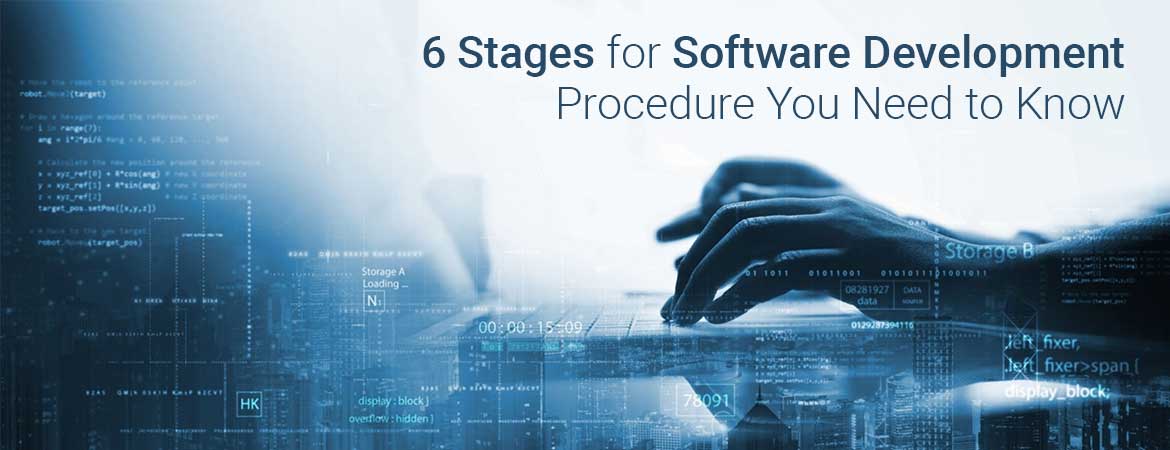
We use cookies to ensure that we give you the best experience on our website.
By using this site, you agree to our use of cookies. Find out more.
Following the proper software development procedure can help create robust applications that meet users' needs. So, let's jump into the 6 stages of software development you need to know!

Software is an integral part of our lives and has become essential for businesses to operate efficiently. But how is software created? The software development process follows certain stages and methodologies in order to deliver a high-quality product on time and within budget. This blog will discuss the 6 key stages involved in the software development life cycle (SDLC) along with some popular SDLC models and benefits.
We will start with understanding what exactly software development means and then go through each stage of software development - from gathering requirements to coding, testing, deployment, and maintenance.
Software development is the process of conceiving, specifying, designing, programming, documenting, testing, and bug-fixing involved in creating and maintaining applications, frameworks, or other software components. Software development is a process of writing and maintaining the source code, but in a broader sense, it includes all that is involved from the conception of the desired software through to the final manifestation of the software. It includes requirements specification, design, implementation, testing, and maintenance.
Software development uses various tools to assist in the programming aspects of software development including integrated development environments like Eclipse, code editors, repositories, version control systems, compilers, and debuggers. The software development life cycle consists of several phases including analysis of requirements, design, implementation, testing, and deployment. The primary goal of Mobile App Development Company is to provide value to the business and meet the end user�s needs while keeping the cost under budget and within the deadlines.

Here are the key stages involved in the software development procedure:
The first step in the software development process is gathering and analyzing requirements. Requirements come from stakeholders like end users, customers, business analysts, and management. Requirements are gathered through methods like interviews, questionnaires, observations, and documents. Then requirements are analyzed for completeness, ambiguity, consistency, and feasibility. Unclear requirements are clarified.
Once finalized, requirements are prioritized and documented in artifacts like use cases, user stories, and requirements specifications. This provides a baseline for the rest of the development stages. Any discrepancies between the actual software produced and requirements lead to rework, delays, and cost overruns. So gathering accurate requirements upfront is critical to the success of the entire software development project.
Once requirements have been finalized, the next step is to design the software architecture and flow. This stage involves high-level design where the overall system architecture is decided based on the requirements. Architectural styles like layered architecture, event-driven architecture, and microservice architecture are evaluated. The low-level design follows where details like code structure, interfaces, APIs, algorithms, and database design are specified.
The design stage transforms the conceptual requirements into a formal representation. Design tools like UML diagrams, flowcharts, and wireframes are used to visualize and communicate the design. A well-thought-out design lays the foundation for the implementation stage and helps reduce issues during development. The output of the design stage is design documents and diagrams that act as a blueprint for software coders.
The implementation or coding stage is where the actual software development begins according to the designs created in the previous stage. Developers write source code in their selected programming languages to create the software components based on low-level design specifications. The code implements the algorithms, data structures, classes, functions, and interfaces specified in the design. Developers work collaboratively using source code management tools. They follow coding standards and best practices to make the code efficient, readable, reusable, and maintainable.
Unit testing is performed after developing each program module to ensure it meets specifications and identifies errors early. As coding progresses, integrated modules are tested through integration testing. Once coding is complete, an executable software product is obtained which moves to the next stage of testing.
After the software is developed, it undergoes various stages of testing to identify defects, ensure quality and confirm that it meets the specified requirements. Different types of testing are performed at this stage like unit testing, integration testing, system testing, user acceptance testing, regression testing, etc. Test cases are designed to cover all functionality, paths, boundaries, and edge cases. Both black box and white box testing techniques are used.
Automated testing tools help run an extensive set of test cases efficiently. During testing, defects or bugs are identified, documented, and fixed by reworking the code. This process continues in iterations until the software passes all tests. Once testing is complete, the software is ready to be deployed in the production environment for actual use.
After the software passes all testing, it moves to the deployment stage. Deployment refers to moving the software to its intended target environment for actual use. For on-premise software, this involves installing and configuring the application on target servers, databases, and other infrastructure. For cloud-based software, deployment involves releasing the application onto the cloud platform.
Activities during deployment include data and database migration, setup and configuration of environments, production server setup, user authentication setup, training of end-users, and documentation updates. The goal is to minimize disruption and downtime during deployment. Deployment is often done in stages from development to testing to staging and finally to the production environment. Post-deployment monitoring and support ensure any issues are identified and resolved quickly.
Even after successful deployment, the software requires continued maintenance to fix defects, improve performance, add new features, and make modifications. The maintenance stage ensures the software continues to meet the changing business needs over time. Maintenance activities follow the same software development life cycle on a smaller scale and include requirements gathering, design, development, testing, and deployment of the changes.
Developers monitor customer feedback, bug reports, and usage patterns to identify areas for improvement. Regular software updates and patches are released to fix issues, plug security holes and incorporate new functionality. Proper documentation is maintained during maintenance to onboard new developers and make future enhancements easier. The maintenance stage can continue for the entire lifespan of the software product.
Here are some benefits of following a proper software development life cycle (SDLC):
Here are some popular software development process models:
Waterfall Model -
A sequential linear model where each phase must be completed before the next begins. Simple and easy to understand but inflexible.
V-Model -
A variation of the waterfall model where testing is performed in parallel with development. More structured but still inflexible.
Incremental Model -
Requirements are divided into increments and each increment goes through the SDLC. More flexible but coordination is difficult.
Spiral Model -
Combines elements of the waterfall model and prototyping. More risk-driven and flexible. Suited for large complex projects.
Agile Model -
Iterative approach focusing on adaptation to change and rapid delivery of working software. Common agile methods are Scrum, XP, Kanban, etc. Suited for rapidly changing requirements.
Rapid Application Development (RAD) -
Focuses on rapid prototyping. Working prototypes are developed early to get quick feedback.
Big Bang/Ad Hoc Model -
No specific life cycle is followed. Code is developed and tested all at once. Chaotic and error-prone.
Following a proper software development procedure with defined stages is essential for developing quality software within budget and timeline. The 6 key stages of gathering requirements, design, implementation, testing, deployment, and maintenance form a systematic approach that reduces risks and controls costs. Adhering to these best practices results in software products that meet user needs, and are reusable, maintainable, and of high quality.
By implementing the right software development process for your project, you can develop high-quality apps for your customers. So choose the software development procedure and model that works best for your business needs and team. Proper planning, documentation, and communication throughout each stage will help guide you to a successful product launch.
Leave a Comment
Your email address will not be published.